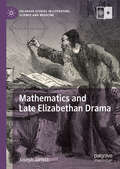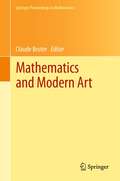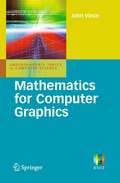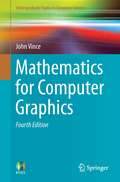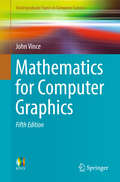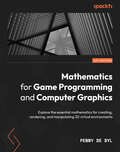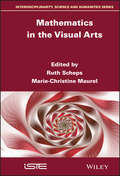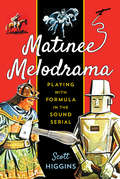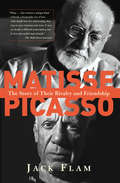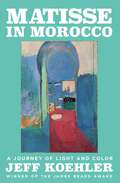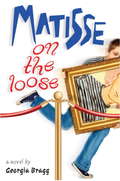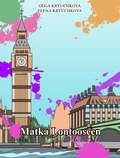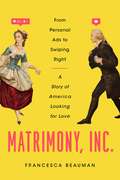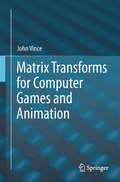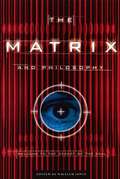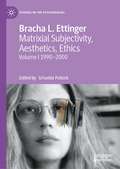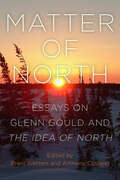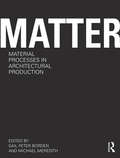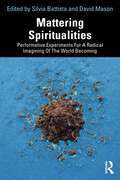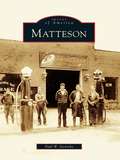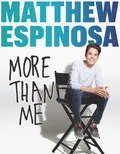- Table View
- List View
Mathematics and Late Elizabethan Drama (Palgrave Studies in Literature, Science and Medicine)
by Joseph JarrettThis book considers the influence that sixteenth-century and early seventeenth-century mathematical thinking exerted on the writing and production of popular drama between about 1587 and 1603. It concentrates upon six plays by five early modern dramatists: Tamburlaine, Part 1 (1587) and Tamburlaine, Part 2 (1587) by Christopher Marlowe; Friar Bacon and Friar Bungay (1589) by Robert Greene; Old Fortunatus (1599) by Thomas Dekker; Hamlet (1600) by William Shakespeare; and The Tragedy of Hoffman (1603) by Henry Chettle. Each chapter analyses how the terms, concepts, and implications of contemporary mathematics impacted upon these plays’ vocabularies, forms, and aesthetic and dramaturgical effects and affects.
Mathematics and Modern Art
by Claude BruterThe link between mathematics and art remains as strong today as it was in the earliest instances of decorative and ritual art. Arts, architecture, music and painting have for a long time been sources of new developments in mathematics, and vice versa. Many great painters have seen no contradiction between artistic and mathematical endeavors, contributing to the progress of both, using mathematical principles to guide their visual creativity, enriching their visual environment with the new objects created by the mathematical science. Owing to the recent development of the so nice techniques for visualization, while mathematicians can better explore these new mathematical objects, artists can use them to emphasize their intrinsic beauty, and create quite new sceneries. This volume, the content of the first conference of the European Society for Mathematics and the Arts (ESMA), held in Paris in 2010, gives an overview on some significant and beautiful recent works where maths and art, including architecture and music, are interwoven. The book includes a wealth of mathematical illustrations from several basic mathematical fields including classical geometry, topology, differential geometry, dynamical systems. Here, artists and mathematicians alike elucidate the thought processes and the tools used to create their work
Mathematics for Computer Graphics
by John A. VinceJohn Vince explains a wide range of mathematical techniques and problem-solving strategies associated with computer games, computer animation, virtual reality, CAD, and other areas of computer graphics. Covering all the mathematical techniques required to resolve geometric problems and design computer programs for computer graphic applications, each chapter explores a specific mathematical topic prior to moving forward into the more advanced areas of matrix transforms, 3D curves and surface patches. Problem-solving techniques using vector analysis and geometric algebra are also discussed. All the key areas are covered including: Numbers, Algebra, Trigonometry, Coordinate geometry, Transforms, Vectors, Curves and surfaces, Barycentric coordinates, Analytic geometry. Plus - and unusually in a student textbook - a chapter on geometric algebra is included.
Mathematics for Computer Graphics
by John VinceJohn Vince explains a wide range of mathematical techniques and problem-solving strategies associated with computer games, computer animation, virtual reality, CAD and other areas of computer graphics in this updated and expanded fourth edition. The first four chapters revise number sets, algebra, trigonometry and coordinate systems, which are employed in the following chapters on vectors, transforms, interpolation, 3D curves and patches, analytic geometry and barycentric coordinates. Following this, the reader is introduced to the relatively new topic of geometric algebra, and the last two chapters provide an introduction to differential and integral calculus, with an emphasis on geometry. Mathematics for Computer Graphics covers all of the key areas of the subject, including: Number sets Algebra Trigonometry Coordinate systems Transforms Quaternions Interpolation Curves and surfaces Analytic geometry Barycentric coordinates Geometric algebra Differential calculus Integral calculus This fourth edition contains over 120 worked examples and over 270 illustrations, which are central to the author's descriptive writing style. Mathematics for Computer Graphics provides a sound understanding of the mathematics required for computer graphics, giving a fascinating insight into the design of computer graphics software and setting the scene for further reading of more advanced books and technical research papers.
Mathematics for Computer Graphics
by John VinceJohn Vince explains a wide range of mathematical techniques and problem-solving strategies associated with computer games, computer animation, virtual reality, CAD and other areas of computer graphics in this completely revised and expanded fifth edition. The first five chapters cover a general introduction, number sets, algebra, trigonometry and coordinate systems, which are employed in the following chapters on vectors, matrix algebra, transforms, interpolation, curves and patches, analytic geometry and barycentric coordinates. Following this, the reader is introduced to the relatively new topic of geometric algebra, followed by two chapters that introduce differential and integral calculus. Finally, there is a chapter on worked examples. Mathematics for Computer Graphics covers all of the key areas of the subject, including: #65533; Number sets #65533; Algebra #65533; Trigonometry #65533; Coordinate systems #65533; Determinants#65533; Vectors #65533; Quaternions #65533; Matrix algebra #65533; Geometric transforms #65533; Interpolation #65533; Curves and surfaces #65533; Analytic geometry #65533; Barycentric coordinates #65533; Geometric algebra #65533; Differential calculus #65533; Integral calculus This fifth edition contains over 120 worked examples and over 320 colour illustrations, which are central to the author's descriptive writing style. Mathematics for Computer Graphics provides a sound understanding of the mathematics required for computer graphics, giving a fascinating insight into the design of computer graphics software and setting the scene for further reading of more advanced books and technical research papers.
Mathematics for Game Programming and Computer Graphics: Explore the essential mathematics for creating, rendering, and manipulating 3D virtual environments
by Penny de BylA comprehensive guide to learning fundamental 3D mathematical principles used in games and computer graphics by exampleKey FeaturesGet acquainted with the essential mathematics needed to describe, simulate, and render 3D creationsConstruct and manipulate 3D animated environments using Python, Pygame, and PyOpenGLDevelop vertex and fragment shaders in OpenGL shader language to speed up renderingBook DescriptionMathematics is an essential skill when it comes to graphics and game development, particularly if you want to understand the generation of real-time computer graphics and the manipulation of objects and environments in a detailed way. Python, together with Pygame and PyOpenGL, provides you with the opportunity to explore these features under the hood, revealing how computers generate and manipulate 3D environments.Mathematics for Game Programming and Computer Graphics is an exhaustive guide to getting “back to the basics” of mathematics, using a series of problem-based, practical exercises to explore ideas around drawing graphic lines and shapes, applying vectors and vertices, constructing and rendering meshes, and working with vertex shaders. By leveraging Python, Pygame, and PyOpenGL, you'll be able to create your own mathematics-based engine and API that will be used throughout to build applications.By the end of this graphics focussed book, you'll have gained a thorough understanding of how essential mathematics is for creating, rendering, and manipulating 3D virtual environments and know the secrets behind today's top graphics and game engines.What you will learnGet up and running with Python, Pycharm, Pygame, and PyOpenGLExperiment with different graphics API drawing commandsReview basic trigonometry and how it's important in 3D environmentsApply vectors and matrices to move, orient, and scale 3D objectsRender 3D objects with textures, colors, shading, and lightingWork with vertex shaders for faster GPU-based renderingWho this book is forThis book is for programmers who want to enhance their 3D mathematics skills relating to computer graphics and computer games. Knowledge of high school–level mathematics and a working understanding in an object-orientated language is needed to grasp the contents present in this book.
Mathematics in Twentieth-Century Literature & Art: Content, Form, Meaning
by Robert TubbsThe author of What Is a Number? examines the relationship between mathematics and art and literature of the 20th century.During the twentieth century, many artists and writers turned to abstract mathematical ideas to help them realize their aesthetic ambitions. Man Ray, Marcel Duchamp, and, perhaps most famously, Piet Mondrian used principles of mathematics in their work. Was it coincidence, or were these artists following their instincts, which were ruled by mathematical underpinnings, such as optimal solutions for filling a space? If math exists within visual art, can it be found within literary pursuits? In short, just what is the relationship between mathematics and the creative arts?In this exploration of mathematical ideas in art and literature, Robert Tubbs argues that the links are much stronger than previously imagined and exceed both coincidence and commonality of purpose. Not only does he argue that mathematical ideas guided the aesthetic visions of many twentieth-century artists and writers, Tubbs further asserts that artists and writers used math in their creative processes even though they seemed to have no affinity for mathematical thinking.In the end, Tubbs makes the case that art can be better appreciated when the math that inspired it is better understood. An insightful tour of the great masters of the last century and an argument that challenges long-held paradigms, this book will appeal to mathematicians, humanists, and artists, as well as instructors teaching the connections among math, literature, and art.“Though the content of Tubbs’s book is challenging, it is also accessible and should interest many on both sides of the perceived divide between mathematics and the arts.” —Choice
Mathematics in Twentieth-Century Literature and Art: Content, Form, Meaning
by Robert TubbsChips away at the notion of an accidental relationship between math and art and literature.During the twentieth century, many artists and writers turned to abstract mathematical ideas to help them realize their aesthetic ambitions. Man Ray, Marcel Duchamp, and, perhaps most famously, Piet Mondrian used principles of mathematics in their work. Was it mere coincidence, or were these artists simply following their instincts, which in turn were ruled by mathematical underpinnings, such as optimal solutions for filling a space? If math exists within visual art, can it be found within literary pursuits? In short, just what is the relationship between mathematics and the creative arts?In this provocative, original exploration of mathematical ideas in art and literature, Robert Tubbs argues that the links are much stronger than previously imagined and exceed both coincidence and commonality of purpose. Not only does he argue that mathematical ideas guided the aesthetic visions of many twentieth-century artists and writers, Tubbs further asserts that artists and writers used math in their creative processes even though they seemed to have no affinity for mathematical thinking. In the end, Tubbs makes the case that art can be better appreciated when the math that inspired it is better understood. An insightful tour of the great masters of the last century and an argument that challenges long-held paradigms, Mathematics in Twentieth-Century Literature and Art will appeal to mathematicians, humanists, and artists, as well as instructors teaching the connections among math, literature, and art.
Mathematics in the Visual Arts
by Marie-Christine Maurel Ruth SchepsArt and science are not separate universes. This book explores this claim by showing how mathematics, geometry and numerical approaches contribute to the construction of works of art. This applies not only to modern visual artists but also to important artists of the past. To illustrate this, this book studies Leonardo da Vinci, who was both an engineer and a painter, and whose paintings can be perfectly modeled using simple geometric curves. The world gains intelligibility through elegant mathematical frameworks – from the projective spaces of painting to the most complex phase spaces of theoretical physics. A living example of this interdisciplinarity would be the sculptures of Jean Letourner, a specialist in both chaos sciences and carving, as evidenced in his stonework. This book also exemplifies the geometry and life of forms through contemporary works of art – including fractal art – which have never before been represented in this type of work.
Matinee Melodrama
by Scott HigginsLong before Batman, Flash Gordon, or the Lone Ranger were the stars of their own TV shows, they had dedicated audiences watching their adventures each week. The difference was that this action took place on the big screen, in short adventure serials whose exciting cliffhangers compelled the young audience to return to the theater every seven days. Matinee Melodrama is the first book about the adventure serial as a distinct artform, one that uniquely encouraged audience participation and imaginative play. Media scholar Scott Higgins proposes that the serial's incoherent plotting and reliance on formula, far from being faults, should be understood as some of its most appealing attributes, helping to spawn an active fan culture. Further, he suggests these serials laid the groundwork not only for modern-day cinematic blockbusters like Star Wars and Raiders of the Lost Ark, but also for all kinds of interactive media that combine spectacle, storytelling, and play. As it identifies key elements of the serial form--from stock characters to cliffhangers--Matinee Melodrama delves deeply into questions about the nature of suspense, the aesthetics of action, and the potentials of formulaic narrative. Yet it also provides readers with a loving look at everything from Zorro's Fighting Legion to Daredevils of the Red Circle, conveying exactly why these films continue to thrill and enthrall their fans.
Matisse and Picasso: The Story of Their Rivalry and Friendship
by Jack FlamMatisse and Picasso achieved extraordinary prominence during their lifetimes. They have become cultural icons, standing not only for different kinds of art but also for different ways of living. Matisse, known for his restraint and intense sense of privacy, for his decorum and discretion, created an art that transcended daily life and conveyed a sensuality that inhabited an abstract and ethereal realm of being. In contrast, Picasso became the exemplar of intense emotionality, of theatricality, of art as a kind of autobiographical confession that was often charged with violence and explosive eroticism. In Matisse and Picasso, Jack Flam explores the compelling, competitive, parallel lives of these two artists and their very different attitudes toward the idea of artistic greatness, toward the women they loved, and ultimately toward their confrontations with death.
Matisse in Morocco: A Journey of Light and Color
by Jeff KoehlerThe remarkable and little-known story of the two groundbreaking winters that Henri Matisse spent painting in Morocco, a fertile period that transformed his art and marked his work until the very end.In winter of 1912, Henri Matisse—forty-two, nearing mid-career, and yet to find lasting critical acceptance, public admiration, or financial security since exploding to the forefront of the avant-garde in 1905 with his iconoclastic Fauve paintings—was struggling. Once the vanguard leader, the Parisian avant-garde now considered him passé. His important early collectors, including Gertrude and Leo Stein, had stopped buying his work and were fully championing Picasso, and he had exhibited little in the last few years. In the face of Cubism that was now dominating the art scene, Matisse needed to get away from Paris in order to advance his distinctive artistic vision. Almost on a whim, he went to Tangier. Matisse had already been profoundly inspired by Islamic art, and was primed for his arrival in the Moroccan city where such art was integrated into everyday life. Despite the challenges of rain, insomnia, depression, and finding models, the sojourn was such a success he returned the following winter, which would lead to even greater artistic triumph. Matisse in Morocco tells the story of the artist's groundbreaking time in Tangier and how it altered Matisse&’s development as a painter and indelibly marked his work for the next four decades. Through Koehler's research and travel, we experience Matisse's time in Tangier, the paintings and their subjects, his relationships with his wife Amélie and his two important collectiors, and then come to understand the impact Morocco—its light, colors, culture, and artistic traditions—had on his art. From Landscape Viewed From a Window, to Zorah on the Terrace, from Kasbah Gate to the dream-like tableau Moroccan Café, these works from Morocco are now recognized as some of the most significant and dazzling of Matisse&’s illustrious career.
Matisse on the Loose
by Georgia BraggA kid. A famous painting. A cool moment. A prison sentence?Have you ever done something you shouldn't have? But you're a good person and you don't think that it's going to cause any real harm? But then something bad happens and it turns out that you were wrong? Welcome to Matisse's world. Matisse has finally got the chance to come face to face with the work of his namesake, the great French painter Henri Matisse. The museum where his mom works as head of security is hosting a Matisse exhibit. Matisse thought it would be cool to hang his own artwork--a copy of a famous Matisse painting, Portrait of Pierre--on the museum wall just for a minute. But then a tour group thinks that it's a real Matisse. So now Matisse's painting hangs in a museum--while the priceless original hangs on Matisse's eccentric family's den wall. A sixth grader should not get caught up in a museum heist. But . . . what if he does?From the Hardcover edition.
Matka Lontooseen (Antistress-kirjoja #5)
by Olga Kryuchkova Elena KryuchkovaTämä kirja on omistettu Lontoon kauniin maisemiin. Se sisältää värivalokuvia ja niihin liittyviä kuvauksia sekä mustavalkoisia kuvia. Halutessasi voit ottaa näyttökuvan värittääksesi sen tietokoneella tai värittää tulostetulla paperilla. Värittäessäsi saa ottaa värivalokuvan väriskeemaa tai valita värejä itse. Sen jälkeen voit selailla Lontoon nähtävyysten kuvia internetissä, joka tulee olla mielenkiintoista. Tämä kirja auttaa sinua selviytyä masennuksesta, tehdä luomistyötä, rauhoittua, nauttia piirtämisprosessista ja matkustaa Lontooseen henkisesti sekä ottaa mieleen uusia tietoja kaupungista. Kirjalle ei annettu ikärajoja.
Matrimony, Inc.: From Personal Ads to Swiping Right, A Story of America Looking for Love
by Francesca BeaumanA clever, thoughtful, and funny history that reveals how the Union of states was built on a much more personal union of people. Have you ever used a dating app or website? Then you have more in common than you know with lonely homesteaders in 18th century New England. At once heartwarming and heartbreaking, Matrimony, Inc. reveals the unifying thread that weaves its way through not just marriage and relationships over the centuries, but American social history itself: advertising for love. Amazingly, America&’s first personal ad appeared in the Boston Evening Post as early as 1759. A &“person who flatters himself that he shall not be thought disagreeable&” was in search of a &“young lady, between the age of eighteen and twenty-three, of a middling stature, brown hair, of good Morals…&” As family-arranged marriages fell out of fashion, "Husband Wanted" or "Seeking Wife" ads were soon to be found in every state in the nation. From the woman in a Wisconsin newspaper who wanted &“no brainless dandy or foppish fool&” to the man with a glass eye who placed an ad in the New York Times hoping to meet a woman with a glass eye, the many hundreds of personal ads that author Francesca Beauman has uncovered offer an extraordinary glimpse into the history of our hearts&’ desires, as well as a unique insight into American life as the frontier was settled and the cities grew. Personal ads played a surprisingly vital role in the West: couple by couple, shy smile by shy smile, letter by letter from a dusty, exhausted miner in California to a bored, frustrated seamstress in Ohio. Get ready for a new perspective on the making of modern America, a hundred words of typesetter&’s blurry black ink at a time. &“So anxious are our settlers for wives that they never ask a single lady her age. All they require is teeth,&” declared the Dubuque Iowa News in 1838 in a state where men outnumbered women three to one. While the dating pools of 21st century New York, Chicago or San Francisco might not be quite so dentally-fixated, Matrimony Inc. will put idly swiping right on Tinder into fascinating and vividly fresh historical context. What do women look for in a man? What do men look for in a woman? And how has this changed over the past 250 years?
Matrix Transforms for Computer Games and Animation
by John VinceMatrix transforms are ubiquitous within the world of computer graphics, where they have become an invaluable tool in a programmer's toolkit for solving everything from 2D image scaling to 3D rotation about an arbitrary axis. Virtually every software system and hardware graphics processor uses matrices to undertake operations such as scaling, translation, reflection and rotation. Nevertheless, for some newcomers to the world of computer games and animation, matrix notation can appear obscure and challenging. Matrices and determinants were originally used to solve groups of simultaneous linear equations, and were subsequently embraced by the computer graphics community to describe the geometric operations for manipulating two- and three-dimensional structures. Consequently, to place matrix notation within an historical context, the author provides readers with some useful background to their development, alongside determinants. Although it is assumed that the reader is familiar with everyday algebra and the solution of simultaneous linear equations, Matrix Transforms for Computer Games and Animation does not expect any prior knowledge of matrix notation. It includes chapters on matrix notation, determinants, matrices, 2D transforms, 3D transforms and quaternions, and includes many worked examples to illustrate their practical use.
Matrix and Philosophy: Welcome to the Desert of the Real
by William IrwinThe thought-provoking essays discuss different facets of the primary philosophical puzzle of The Matrix: Can we be sure the world is really there, and if not, what should we do about it? Other chapters address issues of religion, lifestyle, pop culture, the Zeitgeist, the nature of mind and matter, and the reality of fiction.
Matrixial Subjectivity, Aesthetics, Ethics: Volume 1 1990–2000 (Studies in the Psychosocial)
by Bracha L. EttingerThis book is the first of two volumes that, together, present for the first time a comprehensive collection of three decades of the theoretical writings of artist and theorist Bracha L Ettinger. Edited and introduced by Griselda Pollock they provide a systematic anthology of Ettinger’s path-breaking and influential concept of Matrixial subjectivity-as-encounter and jointness-in-difference, and chart her radical intervention in aesthetics, ethics and theories of subjectivity far beyond classical feminist and current gender/queer theory.This first volume includes the writings in which Ettinger elaborates her original concepts of Matrixial space-time and metramorphosis, fascinance, wit(h)nessing, resonance, transcryptum, com-passion, self-fragilization and resistance, co-emergence and copoiesis transform theories of the subject, Eros, alliance and love, sexual difference, alterity, relationality, trauma and violence. Her critical dialogue with theorists including Levinas, Lacan, Lyotard and Deleuze & Guattari, Butler, Cavarero and Irigaray is evident here.A leading authority on Matrixial theory, Griselda Pollock provides explanatory prefaces to each chapter and a lengthy introduction that situates Ettinger’s work in relation to socio-psychoanalytical theory and practice and current social and philosophical debates. Ettinger’s interlacing of psychoanalysis, ethics, and aesthetics can be seen here to address some of the deepest challenges of our social, cultural and political existence today.
Matt on Brexit
by Matt Pritchett'However bad the day's news, there'll still be a Matt cartoon the morning after, and we'll still laugh - he's a genius!' Jeremy Vine'Always topical and achingly funny' Jilly CooperFrom the (some say ill-judged) Referendum to the Remain and Leave campaigns with all their twists and turns ... From a vote of No Confidence to the ongoing confusion ... Matt hits the spot every time. Brilliantly entertaining, award-winning Matt can lighten even the most troubling times, and find the perfect cartoon to make the nation smile.
Matt on Brexit
by Matt Pritchett'However bad the day's news, there'll still be a Matt cartoon the morning after, and we'll still laugh - he's a genius!' Jeremy VineFrom the (some say ill-judged) Referendum to the Remain and Leave campaigns with all their twists and turns ... From a vote of No Confidence to the ongoing confusion ... Matt hits the spot every time. Brilliantly entertaining, award-winning Matt can lighten even the most troubling times, and find the perfect cartoon to make the nation smile.
Matter of North: Essays on Glenn Gould and The Idea of North
by Brent Wetters Anthony CushingDocuments and illuminates Glenn Gould's groundbreaking radio composition, The Idea of North.Matter of North collects essays and source material related to Glenn Gould's landmark 1967 radio documentary The Idea of North. The most famous product (other than his studio piano recordings) of Gould's 1964 decision to abandon the concert stage for the recording studio, it combines Gould's interests in the contrapuntal (by the simultaneous layering of speaking voices) with philosophy and a life-long fascination with the Canadian Arctic. Because the documentary is a multivalent work, the contributors approach the documentary from unique perspectives (sociological, philosophical, music-theoretical, ethnomusicological), each illuminating a salient aspect of the work. The source-material section includes for the first time the complete interview responses by Gould's five participants, along with other important documentation.
Matter: Material Processes in Architectural Production
by Michael Meredith Gail Peter BordenBeginning with material, this book revolves around physical material making and design decisions that emerge from material interaction. Combining essays from both practice and academia, this book presents some of the most significant projects and thoughts on materiality from the last decade. Beautifully illustrated with a great deal of technical information throughout, it shows work, technical technique and process, and positions it within a broader theoretical intention. By assembling a range of voices, here is a multifaceted portrait of material design today. Students and design professionals alike should find in this book an essential resource for understanding this increasingly important aspect of design.
Mattering Spiritualities: Performative Experiments for a Radical Imagining of the World Becoming (Routledge Advances in Theatre & Performance Studies)
by David Mason Silvia BattistaMattering Spiritualities brings together an array of international scholars and practitioners to explore spirituality in embodiment through the lens of performance, performative writing, and performance studies.The book concerns spirituality and takes the body as the site of whatever it is we call spirituality. The methodological assumption is that the opposition of body and spirit is a false binary that calls for re-examination and revision. It stems from the argument that people can deliberately shift their boundaries of perception and knowing through practice, technologies and performative techniques that can alter the way in which they perceive the ecologies in which they are embedded. This approach understands that careful attention to which bodies are performing in any given scenario is crucial, as is a sensitivity to the ramifications of any body’s race, gender, class, and biological ability. Performance can therefore be regarded as anything through which individuals and collectives experiment with bodies as technologies. Each chapter engages with such experiments to explore how bodies experience and relate to other bodies, human and other-than-human, but also how, by mobilizing bodies and changing relationships between them, practitioners can transform people, spaces and places, objects, ecologies large and small, and shift the borders-of-the-known. Such experiments can also reveal intersectional dynamics within given social, political, and biological borders offering new perspectives and angles of analysis.This collection intends to serve transdisciplinary studies and to support varied learning and teaching environments for undergraduate, postgraduate, and PhD students.
Matteson (Images of America)
by Paul W. JaenickeThe village of Matteson was founded in 1855 and named after the 10th governor of Illinois, Joel Matteson. German immigrants were the area's first settlers, seeking agriculture and business opportunities. The Illinois Central and Michigan Central Railroads provided the stimulus for the growth of one of the first communities to the south of Chicago. The area became popular in the 1890s, when Chicago residents rode special trains to visit the amusement park run by Moses and Freeman Elliott. By the mid-20th century, the town had established itself as a growing bedroom community due to the electrification of the Illinois Central suburban service in 1926 and an increase in residential housing designed for American GIs returning home after World War II. Transportation has always played a key role in the development of the village, which sits at the crossroads of America's first land grant railroad, the Illinois Central, and the country's first transcontinental road, the Lincoln Highway. Since the 1970s, Matteson has grown intoa vibrant retail and commercial area for Chicago's south suburbs.
Matthew Espinosa: More Than Me
by Matthew EspinosaYou may think you know everything about multiplatform entertainer Matthew Espinosa—but he’s here to tell you so much more in his debut book, full of hundreds of brand-new pictures from a series of exclusive photo shoots.You know Matthew is burning up the internet with more than 18 million fans across YouTube, Vine, Instagram, Twitter, and Facebook. You know about his starring role in the hit movie Be Somebody. And you know he makes you laugh every time.More Than Me tells you what you don’t know, with tons of photos, Q&As, and more that offer an inside look at Matthew’s life and a new side of him that’s hilarious and heartfelt. For the first time, Matthew wants to let the world in on the true story of his wild ride to success and why he loves what he does. In this must-have for any fan, Matthew is ready to share how legendary you can all be—together. More Than Me cover credit Chris Eckert.
